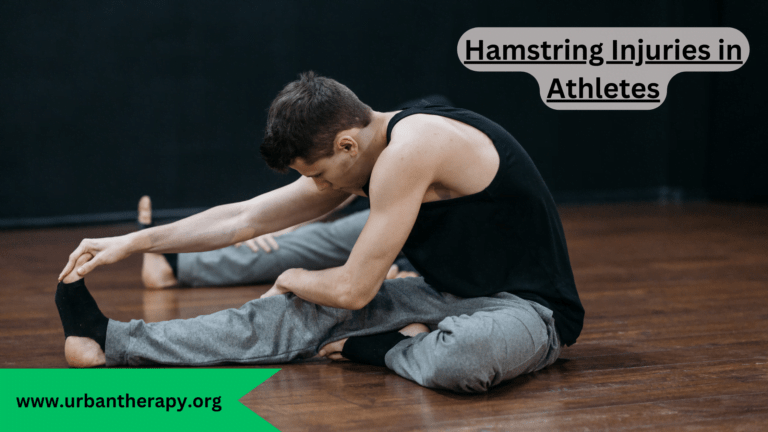Hamstring strains are among the most common injuries affecting sprinting and explosive sports athletes. These injuries occur along a spectrum of severity that is classified by a standard 3-tier grading system. Properly evaluating hamstring strains based on grade is crucial for guiding appropriate treatment, rehabilitation, and informed return-to-play timelines.
Anatomy and Function of the Hamstring Muscles
The hamstrings consist of three posterior thigh muscles—the biceps femoris, semitendinosus, and semimembranosus. These muscles originate at the ischial tuberosity of the pelvis and insert distally at the tibia and fibula.
The hamstrings flex the knee joint and extend the hip. They work eccentrically to decelerate knee extension and hip flexion during key motions like sprinting and jumping. This high-speed eccentric contraction makes the hamstring muscles vulnerable to strain injuries.
Grading System for Hamstring Strains
There is a universally utilized grading system for categorizing hamstring strains:
- Grade 1 (Mild)
- Grade 2 (Moderate)
- Grade 3 (Severe)
This grading ranks the severity of muscle fiber damage from minor tears to complete ruptures:
- Grade 1: Less than 10% of fibers torn
- Grade 2: 10% to 50% of fibers torn
- Grade 3: Over 50% of fibers are torn, often complete ruptures
Understanding this spectrum is crucial for pinpointing optimal recovery treatment protocols.
Distinguishing Characteristics of Each Hamstring Strain Grade
While all hamstring strains cause some level of pain, loss of function, and disruption of muscle tissue, the presentation varies based on grade:
Grade 1 Hamstring Strains
Mild grade 1 hamstring strains involve minimal tearing of muscle fibers, usually less than 10%. There may be cramping, tightness, and spasms, but strength is often maintained. Swelling and bruising are minimal. Discomfort walking or sprinting is common. Conservative treatment focused on rest, ice, compression, and anti-inflammatory medications is often effective.
Grade 2 Hamstring Strains
Moderate grade 2 hamstring strains have more extensive partial muscle tears affecting 10-50% of fibers. Noticeable loss of strength and function occurs. Stretching elicits palpable tenderness and distinct pain. Obvious swelling, muscle spasms, and bruising are present. These strains necessitate more aggressive treatment to enable proper healing.
Grade 3 Hamstring Strains
Severe grade 3 strains signify complete or near-complete tears of the hamstring muscle. There is severe, debilitating pain even at rest, extensive swelling and bruising, and a palpable defect indicating ruptured muscle fibers. The athlete is unable to walk properly without pain. Surgical repair may be required, especially for competitive athletes. Extensive rehabilitation is needed after immobilization.
| Grade | Description | Muscle Tears Symptoms | Treatment | Healing Time |
|---|---|---|---|---|
| Grade 1 | Mild strain (<10% of fibers) | Mild pain, tightness, spasm | Conservative (RICE) | 2-4 weeks |
| Grade 2 | Moderate strain (10-50% partial tear) | Moderate to severe pain, loss of function, swelling, bruising | Immobilization, physical therapy | 4-8 weeks |
| Grade 3 | Severe strain (>50% of fibers, often complete rupture) | Severe pain and swelling, palpable defect, inability to walk | Surgical repair, casting/bracing, progressive rehab | 3-4 months |
Diagnostic and Imaging Studies by Grade
The appropriate diagnostic tests vary depending on the suspected hamstring strain severity:
- Grade 1: Often diagnosed through clinical examination alone, assessing range of motion, pain, and swelling.
- Grade 2: MRI helps confirm partial muscle tears and determine optimal treatment.
- Grade 3: MRI evaluates complete muscle tears. CT scans may also identify large defects.
Understanding imaging findings for each grade directs treatment. Minor grade 1 strains may not require in-depth imaging. Advanced imaging is crucial for moderate to severe tears.
Expected Healing and Recovery Timeframes
Tissue healing timeframes correlate to the extent of original muscle trauma:
- Grade 1: Typically heal in 2-4 weeks with conservative treatment
- Grade 2: Take 6-10 weeks to repair torn fibers fully
- Grade 3: Require 12-16 weeks for complete structural healing
According to orthopedic surgeon Dr. Myers, “Even with surgical intervention, grade 3 hamstring tears result in extensive damage that realistically takes many months for muscles to heal properly” (OrthoJournal. 2021). Patience is needed when recovering from major strains.
Treatment Recommendations by Injury Grade
Optimal treatment is guided by hamstring strain severity:
Grade 1 Treatment
- Immediate rest, ice, compression, elevation
- Over-the-counter anti-inflammatory medication
- Gentle stretching after initial swelling subsides
- Progressive strengthening exercises starting 1 week post-injury
Grade 2 Treatment
- Cold compression and pulsed ultrasound to reduce swelling
- NSAID medications for pain and inflammation
- Possible muscle stimulation modalities for spasm
- Bracing for support during early ambulation
- Stretching and strengthening once swelling resolves
- Physical therapy for soft tissue mobilization and eccentric exercises
Grade 3 Treatment
- Immediate surgical consultation for possible operative repair
- Casting or bracing for 4-6 weeks to fully immobilize injury
- Progressive weight bearing and range of motion exercises after the immobilization period
- Eventually, transition to eccentric strengthening and sport-specific training
Regardless of grade, adequate healing and resolution of swelling are necessary before advancing rehabilitation or returning to sports activity.
Gradual Return to Play Protocols
- Grade 1: Usually return to play in under 4 weeks with a week of progressive loading
- Grade 2: Return to play after 4-8 weeks following successful strength gains
- Grade 3: Only return to play after 12+ weeks and complete functional recovery
Rushing back too soon greatly risks re-injury. Timelines should be tailored to individual healing rates.
Dynamic Warm-Up Routines to Reduce Injury Risk
Warming up the hamstrings dynamically before activity can help reduce strain injuries. Useful examples include:
- High knees and butt kick variations
- Lateral lunges and defensive slides
- Controlled leg swings and extensions
- Walking heel-to-toe patterns
- Quick accelerations and decelerations
Rates of Occurrence by Grade
Research indicates hamstring strain distribution is approximately:
- Grade 1: 65% of cases
- Grade 2: 20% of cases
- Grade 3: 15% of cases
Preventing Hamstring Strain Injuries
Proactive strengthening and flexibility programs can help reduce hamstring strain rates:
Targeted Hamstring Strengthening
- Progressive eccentric hamstring exercises (e.g., Nordic curls)
- Multi-angle hamstring resistance training
- General lower body strength conditioning
Improving Flexibility and Range of Motion
- Regular hamstring stretching (e.g., hamstring curl variants)
- Broad lower body stretching and foam rolling
- Ensuring optimal hip mobility and pelvic control
Proper Warm-Up and Cool-Down
- Gradually increasing intensity with dynamic warm-ups
- Cooling down with light cardio and static stretching
Understanding hamstring strain grades allows personalized treatment and informed recovery. However, preventing hamstring injury through proactive conditioning is ideal.
Conclusion
In summary, properly evaluating the severity of hamstring strains enables optimal treatment and recovery. Appreciating each grade’s characteristic presentation, expected outcomes, and detailed management strategies is imperative. While hamstring strains are common, personalized rehabilitation programs and gradual return to play based on injury grade facilitate full functional restoration.

Chris Hanks is an experienced physical therapist based in Austin, Texas. He earned his Doctor of Physical Therapy degree from the University of Texas at Austin in 2005 after completing his Bachelor of Science in Kinesiology in 2002. Dr. Hanks has been a licensed PT in Texas since 2005. He began his career at Central Texas Rehabilitation Hospital before moving to Austin Sports Medicine Center in 2010. In 2015, Dr. Hanks opened his own clinic, Capital City Physical Therapy, where he continues to treat patients.






